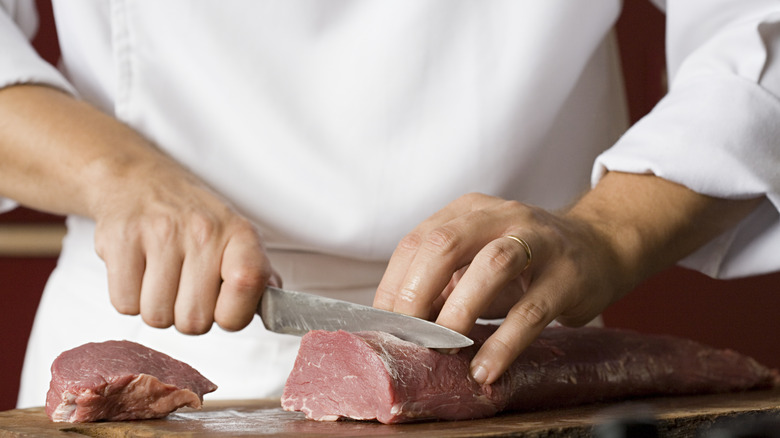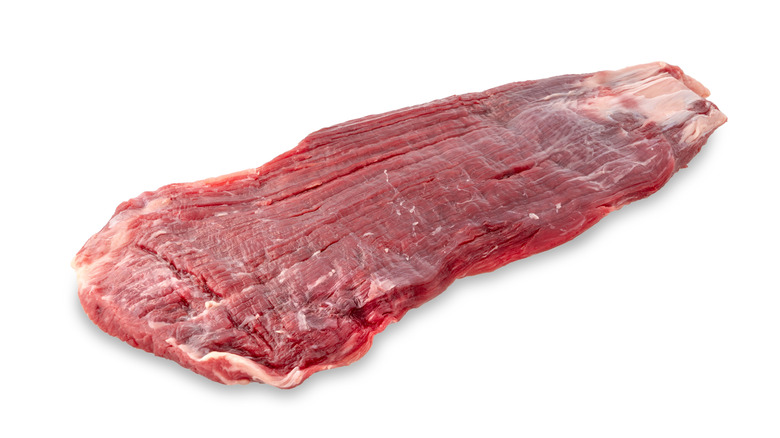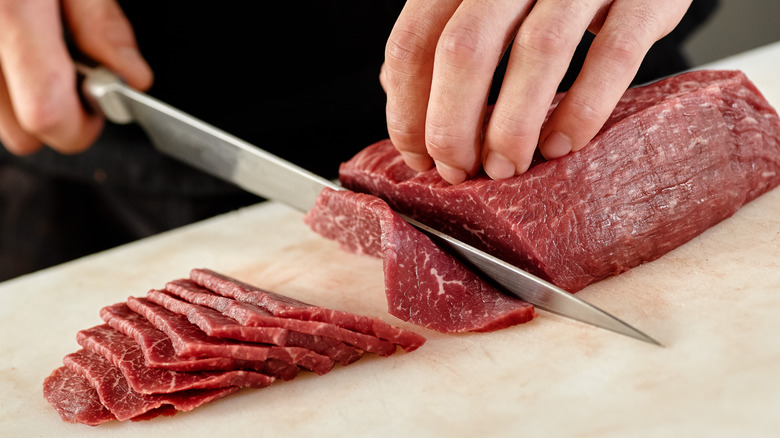What Does It Mean To Cut Meat Against The Grain?
Often, recipes instruct you to slice meat "against the grain." And while you've probably realized in these instances that they're not talking about whole grains or anything of the plant variety, recipes seldom actually explain what this directive means — and why it's so important. Chefs and butchers use the term "grain" in the same way that woodworkers do. If you've ever seen a piece of lumber, you've surely noticed that there are thin stripes running up and down it, which are actually wood fibers. Animal muscle also has fibers, and although they don't always stand out as much as those in wood, they also run in parallel lines like pinstripes.
To cut something against the grain means to cut perpendicular to the fibers. This breaks the muscle fibers up into small segments. The opposite of cutting against the grain is called cutting "with the grain," and it leaves long strands of muscle fibers intact. Breaking up the fibers is an important step in preparing many different cuts of meat because it makes the results more tender. Slicing against the grain spares your teeth the tough work of severing massive muscle fibers on their own. Depending on the cut of meat you're working with and the type of dish you're making, the rules about cutting against the grain can vary, so let's get into the details.
Identifying the grain
Generally speaking, the tougher the cut of meat, the easier it's going to be to locate the grain — which is good, because tough cuts are the most important ones to slice properly, lest you end up with chewy results. Cuts of beef such as brisket, flank steak, hanger steak, and skirt steak all have thick muscle fibers because they come from hardworking parts of the cow's body. You should easily be able to spot the stripes along the meat's surface.
Identifying the grain is more challenging when you're working with a tender cut, such as filet mignon. Cuts taken from the cow's back — such as the strip steak and ribeye — also tend to have more marbling, which can obscure the grain. Fortunately, the direction of your slicing is not as important when you are dealing with cuts like these. Whether or not you cut against the grain, the natural tenderness of the meat should make it easy on your teeth, provided you haven't overcooked it.
In general, red meats are easiest to find the grain on, because their deep color creates clear contrast. Identifying the grain on chicken can be challenging, but if you look closely, you should see very thin white lines within the meat. To further complicate matters, the grain on a chicken breast is curved, making it hard to cut against it all the way through. Fortunately, as is the case with beef back cuts, a properly-cooked chicken breast should be tender no matter how you cut it.
When to cut against the grain (and how)
It is much easier to see the muscle fibers in a piece of meat when it's still raw, but if you are cooking individual steaks, you obviously want to serve them whole for each diner to cut on their own. However, if you are making beef stir fry or chicken fajitas, you'll want to slice against the grain prior to cooking. This will not only be easier because the fibers are more apparent, but it will also expose more of the meat to delicious marinades and sauces.
As previously mentioned, cutting against the grain is most vital with tough cuts of meat, but there is one exception: slow-cooked recipes. Slow cooking naturally breaks down tough cuts into tender, shreddable morsels, so cutting against the grain prior to cooking is not essential in those circumstances. If you are going to grill a large piece of meat and slice against the grain for serving, take note of the grain direction while the meat is still raw and keep it in mind for later.
One last tip for cutting against the grain, especially with raw meat — use a very sharp knife and slice as thinly as possible. If you cut the meat into big chunks, you'll still be left with long strands of muscle fiber to chew through. It helps to cut on a bias, meaning that you position your knife at an approximately 45-degree angle to the cutting board, thus increasing the surface area of each piece of meat.


